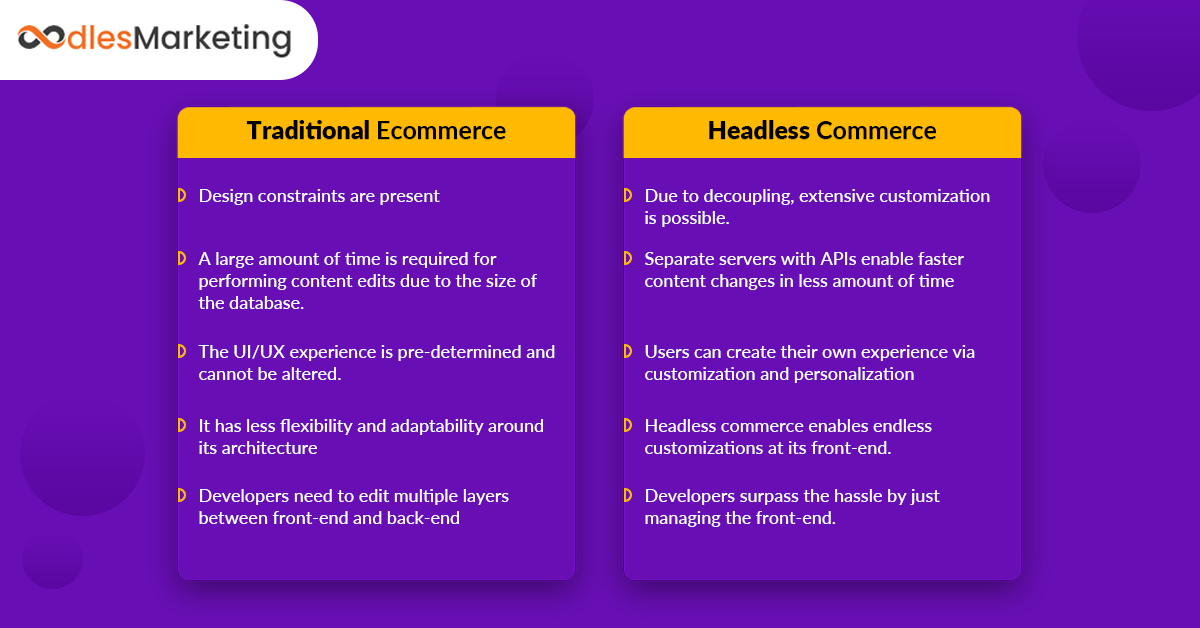
Ecommerce models are rapidly moving towards custom eCommerce solutions. Merchants are facing new needs around their online stores to fulfill their customer’s purchase demands. Merchants are using content creation services for their eCommerce storefronts to create valuable, content-led experiences for their customers.
Evolution of Ecommerce Development Services
(Source: Gartner 2017 report)
Monolithic
The monolithic model is the pioneer eCommerce model. It consists of a single tier of software applications. The front-end and the back-end remain inextricably linked with less scope for customization.
Commerce-led
Commerce-led models deliver a customer-facing web experience. This model is ideal for creating a purchase-led experience, merchandising, and order management efficiency. However, it fails to quickly respond to dynamic customer behavior changes. Also, templates and front-end functionality remain restricted due to which it fails to provide a content-rich experience.
Experience-led
Experience-led eCommerce decouples a platform from its presentation layer. Content Marketing Services play a big role in this model. An experience-led or headless model enables PCI (Payment Card Industry) compliance and inventory management which can be connected to additional tools via APIs (Application Programming Interface).
What is Headless Commerce?
Headless commerce refers to a decoupled eCommerce platform. Headless commerce handles content without a front-end. Front-end is also known as the client-end. In the majority of cases, a front-end consists of themes or templates that provide a graphical user interface. In the absence of a front-end, developers use APIs to design and create custom content. Developers attain architectural flexibility with headless commerce.
Some popular headless eCommerce platforms include Drupal, Magento, and Bigcommerce. Other CMS examples include Acquia, Core DNA, and Adobe experience manager. Ecommerce Development Services in this model assure PCI compliance, security, fraud management, and inventory management. The separation of the front-end from the back-end isolates the display-layer from critical business processes. This way developers can deliver a high-quality content experience for users while focusing on the back-end business functionality separately.
Businesses can benefit a lot from countless customization options. It can be an ideal choice for experience-focused and content-driven brands. Such brands include lifestyle products, direct to consumer (D2C) brands, and brands relying heavily on influencers and native advertising.
To learn more about influencer marketing, read this blog.
Traditional v/s Headless Commerce
The COVID-19 pandemic changed every part of the buyer’s journey. Consumers now control the marketing funnel. According to Bigcommerce’s survey, over 86% of business leaders experienced a rise in customer acquisition costs (CAC).
Here’s how headless commerce holds an edge over traditional eCommerce models and controls CAC for any business.
Commodity e-marketplaces like Amazon set this trend towards headless commerce. Consumers are turning towards personalization and content-driven experiences. Headless commerce addressed this by redefining eCommerce solution services for brands to turn their websites into value destinations for customers.
Benefits of Headless Commerce
Freedom to use any programming language or framework
Traditional eCommerce platforms can impose a specific programming language. Headless commerce facilitates developers to use any language or framework they are familiar with. This cuts down the learning curve and hence saves time.
Cost-saving
Headless solutions tend to be cheaper for scalability as each microservice scales to meet the demand. For example, when traffic spikes on a website, cart and payment APIs scale simultaneously independent of each other to meet the demand and vice-versa.
Integrate with multiple tools
A headless approach enables seamless integration with the best tools for different parts of an eCommerce project. Different tools offer different features and functionality that work harmoniously to achieve project goals. Separate APIs enable easy removal and replacement of tools with advanced versions without going through the entire eCommerce stack.
Effortless optimization
Monolithic platforms take longer to implement any updates or changes to an eCommerce portal. It translates into that it has limited flexibility for changes in the consumer technology landscape. Headless commerce creates success for an eCommerce business with agile testing and optimization.
Improves performance and functionality
Headless solutions function swiftly due to the decoupling of front-end and back-end architecture. Decoupling also enhances its responsiveness and makes it easier to maintain or update.
Conclusion
The rise in the growth of connected devices and digital touchpoints has disconnected the customer experience. Headless technology solves the problem of disconnected experiences. The ability to experiment, learn, and adopt the latest web innovations is pushing consumer expectations for a one-on-one experience. An ideal path to headless commerce would be to unite the finest independent solutions that can integrate seamlessly



























